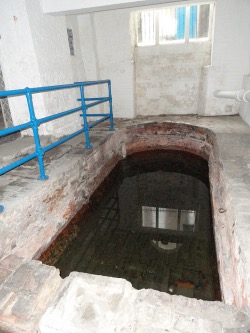Please note: Exploring London is aware that sites across London have closed temporarily as a result of the COVID-19 outbreak. But we’re continuing our coverage as usual – in the hope you can visit at a later time…
Located at 5 Strand Lane in the West End, these brick-lined baths were long-reputed to be of Roman origin. But they are actually believed to be the remains of a cistern built in 1612 to supply water to fountain in the gardens of Old Somerset House.
 The fountain had been built by French engineer, Salomon de Caus, after he was commissioned to do so as part of King James I’s efforts to refurbish Somerset House for Queen Anne of Denmark.
The fountain had been built by French engineer, Salomon de Caus, after he was commissioned to do so as part of King James I’s efforts to refurbish Somerset House for Queen Anne of Denmark.
Following the demolition of the fountain, the cistern was neglected until the 1770s when the cistern was used a public cold plunge bath attached to a property at 33 Surrey Street. A second bath, called the ‘Essex Bath’ was added (it’s now under the nearby KCL Norfolk Building).
The idea that they were Roman is believed to have originated in the 1820s when the bath was so described as an advertising gimmick (Charles Dickens’ helped popularise the idea in his book David Copperfield – it is believed Dickens himself may have bathed here).
The 1.3 metre deep bath passed through a couple of different hands in the ensuing decades including Oxford Street draper Henry Glave and Rev William Pennington Bickford, the Rector of St Clement Danes, who, believing in the bath’s Roman origins, hoped to turn them into a tourist attraction.
But his plans came to nothing due to a lack of funds and following his death, in 1944, the National Trust agreed to take on ownership while London County Council agreed to see to its maintenance. They reopened the baths, following repairs, in 1951.
These days, while owned by the Trust, the baths are managed by Westminster Council.
WHERE: 5 Strand Lane (nearest Tube station is Temple); WHEN: While National Trust properties are temporarily closed, viewings are usually arranged through Westminster Council and Somerset House Old Palaces tour; COST: Free; WEBSITE: www.nationaltrust.org.uk/features/strand-lane-roman-baths.
PICTURE: Michael Trapp (licensed under CC BY-SA 4.0)
